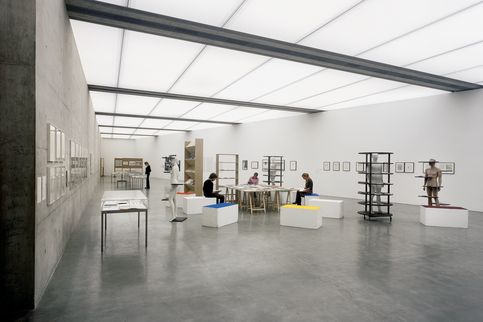... CONCEPT HAS NEVER MEANT HORSE.
Curators: Sabine Breitwieser, Cosima Rainer
Exhibition production: Cosima Rainer
With ...CONCEPT HAS NEVER MEANT HORSE, the Generali Foundation showed the third in a series of exhibitions on themes of the Generali Foundation Collection.
Works by Fareed Armaly, Robert Barry, Pauline Boudry/Brigitta Kuster/Renate Lorenz, Gottfried Bechtold, Kaucyila Brooke, Alice Creischer/Andreas Siekmann, Maria Eichhorn, Andrea Fraser, Dan Graham, Hans Haacke, Mary Kelly, John Knight, Julius Koller, Jarosław Kozłowski, Richard Kriesche, Hans Küng/Dorit Margreiter/Florian Pumhösl/Mathias Poledna, David Lamelas, Dorit Margreiter, Sergey Maslov&Elena Vorobyeva/Viktor Vorobyev, Henrik Olesen, Adrian Piper, Martha Rosler, Allan Sekula, Goran Trbuljak, Tucumán Arde (Archiv Graciela Carnevale), Mierle Laderman Ukeles and Heimo Zobernig.
After two exhibitions displaying specific aspects of the Collection—COLLECTED VIEWS FROM EAST OR WEST (2004), and HOW SOCIETY AND POLITICS GET IN THE PICTURE (2005)—this exhibition addressed questions concerning Conceptual art. Its title is taken from "Achtung!", a text by French Conceptual art pioneer Daniel Buren, and is a reference to the contradictions that have characterized the discussions over Conceptual art since the 1960s.
"Conceptual art" developed translocally in connection with the social and political changes of the 1960s.
While its Anglo-American linguistic variant is most well known, it moreover represents a critical meditation on the medial, institutional, and social conditions of art. Serial structures, schematic procedures, diagrams, text, and theoretical reflections as well as new forms of the dissemination of information expand the artistic range of action.
In a reading area inside the exhibition, historical magazines and publications offered an in-depth view of the variegated and novel forms of artistic production. In the meantime—and in the context of the development of our present communication- and knowledge-based society—these “innovative” strategies have come to be perceived as deeply ambivalent. Setting out from the Generali Foundation’s focus on socio-political and institution-critical approaches in the art of the 1960s and 1970s, the exhibition also showed their reception in the works of a younger, post-Conceptual generation.
The practices of Conceptual art represent an emancipatory movement: artists refused to accept the traditional assignments and definitions of roles as well as the value-system of modernist art criticism and theory. The factors that constitute the system of meaning of art, and its institutions, were rendered problematic. Craftsmanship and subjective expression were renounced in favor of a new positive emphasis on the process of planning and conception. Philosophical and critical considerations upon the production and function of art took center stage. This led to a new perspective on the economic interrelations of art.
Central examples were the works of feminist artists such as Martha Rosler, Mary Kelly, and Mierle Laderman Ukeles. By bringing low-valued occupations such as maintenance and service labor, which are in most cases socially invisible and carry gendered connotations, to the center of their artistic work and hence into the context of art, they destabilized the predominant value-system. A work such as "Keeping of the Keys: Maintenance as Security, July 20" (1973), for which Mierle Laderman Ukeles took on the unlocking and locking of public and administrative museum spaces as part of her “maintenance” work, is seminal for what is called "institutional critique", as is Robert Barry’s "Closed Gallery Piece" (1969) or Gottfried Bechtold’s "Metamorphosis of a Gallery" (1974).
In view of the linguistic variant of Conceptual art, the myth emerged of a dematerialized and market-critical art. From a more recent perspective, it has become apparent that even the “invisible” works of Conceptual art remain sensualist, and that the communication-based Conceptual strategies can be regarded as belonging in the context of advanced marketing strategies. Artists such as Andrea Fraser, John Knight, Küng/Margreiter/Pumhösl/Poledna, or Henrik Olesen have again and again exposed as fictional the critically reserved position that has manifestly defined the Conceptual approach. By addressing their own involvement or thwarting Conceptual procedures, they broach the contradiction that they are themselves part of the system they analyze.
In conjunction with its collection of art, the Generali Foundation aquires historical art magazines, artists’ books, and other rare ephemera. Materials from this collection, otherwise accessible in the study room and only by appointment, were made available to a wider audience in the reading zone, as was the "Lesezimmer II" (Reading Room II) of the Künstlerhaus Stuttgart. The displays in the reading zone were designed by Heimo Zobernig.
To accompany the exhibition, "Art After Conceptual Art," edited by Alexander Alberro and Sabeth Buchmann, was published as the first volume of the "Schriftenreihe Sammlung Generali Foundation," edited by Sabine Breitwieser. The German-language edition was published by Walther König, Cologne, the English-language edition by MIT-Press.







